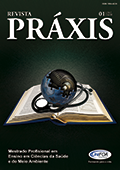Is the Brazilian fauna well represented on children's books?
DOI:
https://doi.org/10.47385/praxis.v11.n22.2270Palavras-chave:
Brazilian fauna, Children’s literature, Science communication, Scientific cultureResumo
This paper examine children books about Brazilian fauna, especially those whose content reveals a potential for science communication. The research was conducted in Brazilian publishers, bookstores and in the Google search engine for books, using the keywords “animals”, “Brazilian animals” and “national fauna”. The content and descriptive analysis was performed in 24 books that presentedwild animals in their natural habitat and portrayed realistically to verify the strategies used in the dissemination of animal biology, focusing on language, content and images.There is a significant number of books about Brazilian animals for children (199), but few are available for purchase (61). Only seven were considered adequate to disseminate animal science, indicating that few books associate scientific knowledge with quality text, bringing together information and aesthetics of the word, as well as beautiful and attractive illustrations. However, all titles play an important role in the popularization of native species.
Downloads
Referências
AMARILLHA, M. Estão mortas as fadas: literatura infantil e prática pedagógica. Petrópolis: Vozes, 1997.
ASSOCIAÇÃO NACIONAL DE LIVRARIAS (2012). Diagnóstico ANL do setor livreiro 2012. Retrieved on November 3, 2012 from: http://anl.org.br/web/diagnostico.html
ARBUTHNOT, M. H. Children and books. Chicago: Scott Foresman and Company, 1957.
BALLOUARD, J-M.; Brischoux, F.; Bonnet, X. Children Prioritize Virtual Exotic Biodiversity over Local Biodiversity. PLoS ONE, v.6, n.8, p.1-8, 2011. doi: 10.1371/journal.pone.0023152
BALMFORD A., CLEGG L., COULSON T., & Taylor J. Why conservationists should heed Pokémon? Science, v.295, p.2367-2371, 2002. doi: 10.1126/science.295.5564.2367b
BARDIN, L. Análise de conteúdo. São Paulo: Edições 70, 2011.
BIZERRIL, M. X. A. Children’s Perceptions of Brazilian Cerrado Landscapes and Biodiversity. The Journal of Environmental Education, v.35, n.4, p.47-58, 1999. doi: 10.3200/JOEE.35.4.47-58
BRASIL. Presidência da República. Secretaria de Comunicação Social. Pesquisa brasileira de mídia 2015: hábitos de consumo de mídia pela população brasileira. Brasília: Secom. Retrieved on January 13, 2016 from:
http://www.secom.gov.br/atuacao/pesquisa
CONVENTION ON BIOLOGICAL DIVERSITY (2016). Brazil - Country Profile: Biodiversity Facts. Retrieved on January 31, 2016 from:
https://www.cbd.int/countries/profile/default.shtml?country=br#facts
EVANS, S.; GARSIDE, C.; GEBBELS, S.; STOCKILL, J.; GRENN, M. The ‘citizens’ day: encouraging young people to acquire, value and use environmental knowledge. School Sci. Rev. v.88, n.325, p.45–50, 2007.
HENLEY, J. Why our children need to get outside and engage with nature, Retrieved on August 16, 2010 from: http://www.guardian.co.uk
HUXHAM, M.; WELSH, A.; BERRY, A.; TEMPLETON, S. Factors influencing primary school children's knowledge of wildlife, Journal of Biological Education, v.41, n.1, p.9-12, 2006. doi: 10.1080/00219266.2006.9656050
INSTITUTO BRASILEIRO DE GEOGRAFIA E ESTATÍSTICA. Perfil dos Municípios Brasileiros: 2015. Rio de Janeiro: IBGE, 2016.
INSTITUTO PRÓ-LIVRO. Retratos da Leitura no Brasil 3. São Paulo: Instituto Pró-livro e Imprensa Oficial do Estado de São Paulo, 2012.
LEWINSOHN, T.L.; PRADO, P.I. Quantas espécies há no Brasil? Megadiversidade v.1, n.1, p.36-42, 2005.
MORA, C.; TITTENSOR, D.P.; ADL, S.; SIMPSON, A.G.B.; WORM, B. How Many Species Are There on Earth and in the Ocean? PLoS Biol v.9, n.8, 2011. doi:10.1371/journal.pbio.1001127
MORGAN, J. M.; GRAMANN, J. H. Predicting effectiveness of wildlife education programs: A study of students' attitudes and knowledge toward snakes. Wildlife Society Bulletin, v.17, n.4, p.501-509, 1989.
PERGAMS, O.; ZARADIC, P. Is love of nature in the US becoming love of electronic media? 16-year downtrend in national park visits explained by watching movies, playing video games, internet use, and oil prices. J Environ Manage, v.80, p.387–393, 2006. doi: 10.1016/j.jenvman.2006.02.001
RAMOS, F. B.; TORQUINST, S. R. A. A construção do poético em Quando as montanhas conversam. Acta Scientiarum. Maringá, v.34, n.1, p.9-15, 2012.
RIBEIRO, R. A.; KAWAMURA, M. R. D. Divulgação científica para o público infantil: potencialidades da revista Ciência Hoje das Crianças In: XIX SIMPÓSIO NACIONAL DE ENSINO DE FÍSICA, 2011, Manaus. Anais... Manaus, Amazonas, Brasil.
SCALFI, G. A. M. Fauna brasileira retratada na literatura infantil: instrumento para divulgação científica, 2014, f... Dissertação (Mestrado em Divulgação Científica) Instituto de Estudos da Linguagem, Universidade Estadual de Campinas, São Paulo, Brasil.
SCHWARZ, M. L., SEVEGNANI, L.; ANDRÉ, P. Representations of the Atlantic Rain forest and its biodiversity through children’s drawings, Ciência & Educação, v.13, n.3, p.369-388, 2007. doi: 10.1590/S1516-73132007000300007
UNION FOR ETHICAL BIO TRADE. UEBT Biodiversity Barometer 2009-2015. Retrieved on March 24, 2016 from: http://ethicalbiotrade.org/dl/UEBT%20-%20EN%20Barometer%202015.pdf











